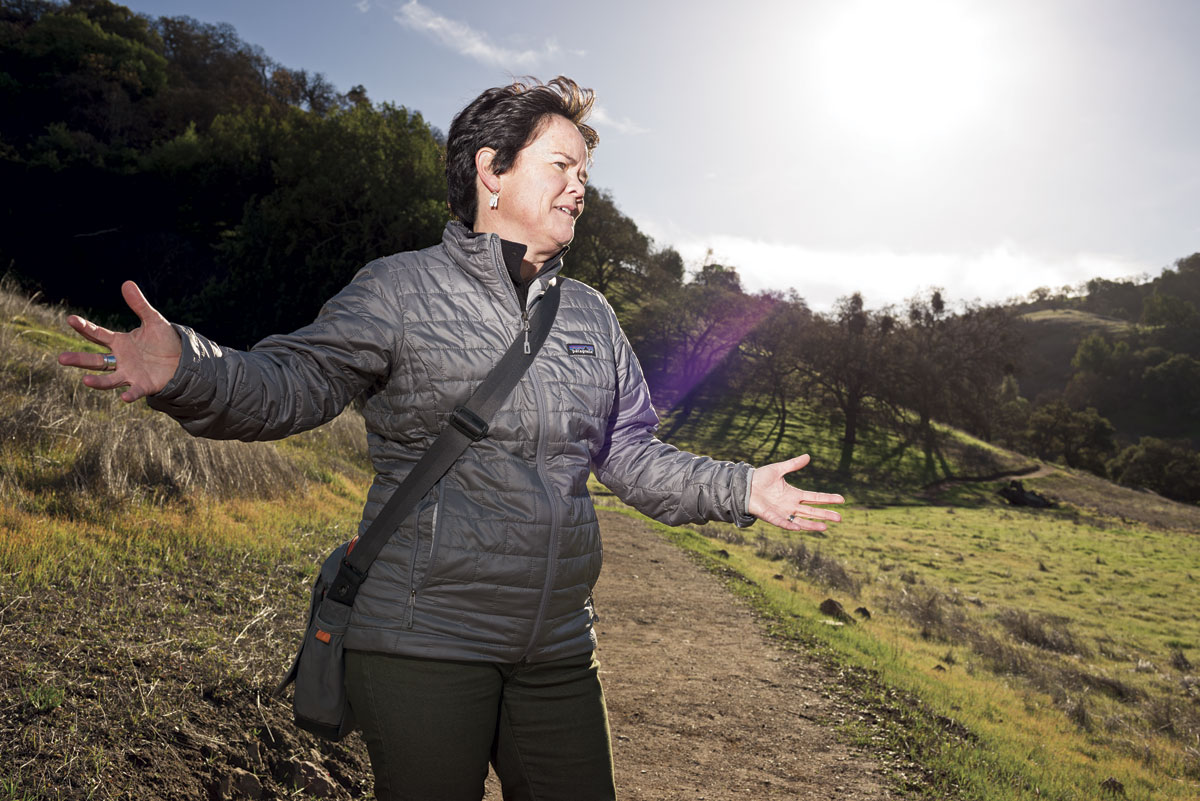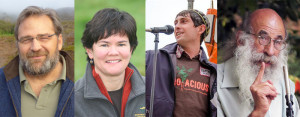It’s mid-afternoon on a blustery day and, taking advantage of a break in the rains, Andrea Mackenzie meets me for a hike at the Coyote Valley Open Space Preserve, a half-mile south of the San Jose city border. Just off busy Highway 101, a small, bumpy road heads west past farm fields until it abruptly ends at the hilly, oak-studded preserve.
Mackenzie rolls up in a silver C-Max hybrid, gets out and, waving hello, walks over to a fallen sign and rights it, then re-secures the yellow caution tape cordoning off an equestrian lot that needs some work. She also notices work that needs doing on the trails that fork out from the parking lot.
Mackenzie, the general manager of the Santa Clara Valley Open Space Authority, won’t be doing the manual labor, but she seems perfectly capable of it. Plucky and compact, with short, dark hair and an even smile, she’s as comfortable in her hiking boots as she is in a suit, and she even admits during our conversation that despite all her collaborations over the years, at her core she’s a “do-it-myselfer.”
As we strike out into the hills, she explains why the open space authority’s newest preserve, the result of a decade-long effort, is so special. Coyote Valley is a natural bridge between the Santa Cruz Mountains and the Diablo Range, and it provides a boundary to sprawling San Jose. I get the feeling that she could pretty much be anywhere and find an open space cause. It’s that much in her DNA.
Santa Clara is the latest stopover in a 25-year career with Bay Area parks and open space agencies, where she’s been a thought leader in policy arenas ranging from tax funding measures to innovative legal agreements with landowners. The result has been tens of thousands of acres of newly preserved open space. As the general manager of Sonoma County’s open space district, Mackenzie expanded the portfolio of preserved lands by 50,000 acres.
A native Angeleno, she grew up on the edge of the Santa Monica Mountains National Recreation Area with plenty of exposure to nature. Nowadays, she lives in San Jose with her partner, Jenni Martin, and daughter, Kiana, 13, as well as their dog, Zeke. I ask her how she got started in open space work.
“Well, it’s funny. When I was growing up all I wanted was to be a National Park ranger. I applied to work in big national parks like Glacier and Yellowstone but never got the call. When I finally got a chance to work as a ranger it was on Alcatraz Island in San Francisco Bay.”
“Not your dream spot, huh?” I say.
“Well, I didn’t think so at first, but something magical happened. I started working in one of the largest urban national park systems in the United States, in the middle of a world-class city. You could really see how important nature was both to the residents and visitors. So, in some ways that was the start of it.”
It was one of her early mentors, Bob Walker, an activist and photographer for the East Bay Regional Park District, who inspired Mackenzie to breathe in the incalculable value of undeveloped lands. At the time a young planner for the park district, Mackenzie turned her attention to the likes of Morgan Territory in Livermore.

As we cross through a cattle gate, I’m reminded that places like Coyote Valley have many uses beyond preserving space for the wild. “Our mission, first and foremost, is protection of natural resources,” she reassures. “When you buy a property like this, it could already have been in agricultural use, so what is the context that the property is in? Is there room to have some traditional agricultural uses without harming biodiversity? In fact, we have an active grazing program here. So, we look at agricultural uses as tools to manage the natural resources on a property: fire prevention, fire management, and invasive species control.”
As we hike uphill, a view opens up of the green meadow below. The oaks are still skeletal, though, waiting for the lengthening light of spring. It’s a classic California landscape, but one that leaders in the open space acquisition world such as Mackenzie spend less time in than they’d like. Desk work and meetings chew up much of their days. “That’s part of the gig, right?” she says.
She concedes she’s most comfortable when her “boots are in the dirt,” and she spends time off relishing her favorite spots—Crissy Field, Mount Tam, Morgan Territory, Rancho Cañada del Oro—and taking backpacking trips with old friends to the eastern side of the Sierras. Her guilty pleasures: chocolate and consuming “mass quantities of national political news.” On the clock, she clearly enjoys taking on the “big picture.“
“What I do best is thinking about how it all fits together,” she says. “I look at a landscape and say, ‘Who’s this benefiting? Whom do we need to bring to the table to protect this place? What resources do we need?’ As the land base shrinks in the Bay Area … we need to convince more and more people who aren’t necessarily trained in conservation about why places like Coyote Valley matter.”
“Broadening the tent” and advancing conservation’s popular appeal is one of her trademark skills. “Even though I have a passion for open space because it’s really priceless,” she says, “you also have to think about open space for the economic benefits it provides, to offer a competing view of the land to somebody who wants to develop it.”
In 2014 she helped launch the first-ever economic valuation of undeveloped lands in Santa Clara County and found they offered $386 billion in services, such as groundwater recharge, flood control, and recreation. She took that argument to the voters later in the year to pass Measure Q, a ballot initiative providing $120 million in open space funding for the county through a parcel tax. The outcome was heartening.
“People don’t know that the majority of our votes came from the residents of San Jose and actually in the poorest neighborhoods. It’s a statement of an aspirational desire for open space and healthy communities. We have thousands of residents in this valley, many of them children, who will never get to Yosemite or Lake Tahoe or even the Santa Cruz shoreline — but they might get to Coyote Valley, and they might see a bobcat or a golden eagle.”
We wind past a stand of fragrant bay laurels, and I ask her what her biggest challenge is.
“It’s pushing the rock uphill,” she says. “It’s incremental successes … it’s getting decision makers and the public to understand the importance of open space, that it’s essential infrastructure for our communities, like schools and roads and bridges… But I feel so fortunate that I have a career that’s my passion,” she reflects. “The decisions we make over the next decade will have huge ramifications for the planet and the next generation. So we need bold thinking, we need innovative thinking, we need outside-the-box thinking. We like to say in our office, ‘Go big or go home.’”


